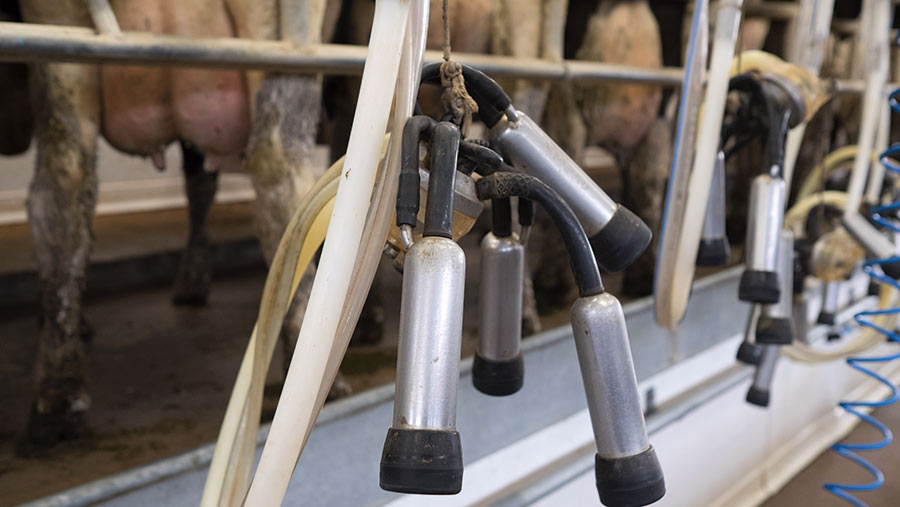Block v year-round calving: Which is best for you?
 © Tim Scrivener
© Tim Scrivener Dairy farmers are being urged to gear up for Brexit by ensuring their production system is competitive and best suited to their target market.
See also: Step-by-step guide to avoiding losses at calving
The levy board launched at strategy at this week’s UK Dairy Day event which suggests producers should identify the production system that will best enable them to compete – and if necessary change their calving pattern.
More than 80% of UK dairy farmers currently identify themselves as year-round calvers. Fewer than 20% of producers operate a block-calving system, where cows are calved within a 12-week window in either spring or autumn.
Each system has merits and limitations. But AHDB Dairy market intelligence analyst Chris Gooderham says the 80:20 split raises the question whether each farmer deliberately decided which system is best for them – or if the situation just evolved.
We look at the pros and cons of block-calving and year-round calving.
How block-calving can drive down costs
The best block-calvers work to extremely high standards – generating labour efficiencies and driving down costs in the process.
All cows usually calve within a 12-week window – in the spring or autumn – before they get back in calf, peak in milk production and are then dried off together. Some farms may operate a looser system where the calving window is longer than 12 weeks.
Higher costs are offset by higher yields and a better price due to seasonality. Spring block-calving herds can produce milk for 2.1-2.3p/litre less than an year-round-calving herd.
The best autumn block-calving herds are just as competitive. For autumn block-calving the cost savings have been 1.1-1.3p/litre.
Savings may be greater since milk profile analysis suggests the blocks are looser than a tight 12-week block-calving system.
Seasonality payments mean typical autumn block-calvers achieve a slightly higher price from standard manufacturing contracts than year-round-calvers.
Spring block-calving herds typically receive 1p/litre less than year-round-calving herds on manufacturing contracts.
Both block-calving herds typically achieve lower prices than year-round-calving herds supplying the liquid market. Price variations differ significantly depending on milk contract.
Producers operating block-calving systems report a significant lifestyle benefit by having a break at certain times of the year.
Case study: David Christensen, Kingston Bagpuize, Oxfordshire

David Christensen
Autumn block-calver David Christensen milks 600 cows at Kingston Hill Farm, Kingston Bagpuize, Oxfordshire. He says he switched to block calving for four key reasons.
“First it was about reducing our cost of production. I could never get as low as some of my colleagues who were block-calvers. It also allowed us to focus on key parts of the year: focusing on calving, focusing on fertility and then focusing purely on grazing.”
As well as seasonal management, other block calving benefits include overall labour savings, potentially higher margins and a break in the regime during the year. But limitations include the need to secure seasonal labour and a potentially lower milk price.
“Autumn block-calving really fits with our local climate – namely a very hot, dry summer,” says Mr Christensen. “I like the fact that we are busy at some times of the year but also much quieter at other times of the year. That allows us to get some time off, relax and think a bit.”.
Year-round system can command premium price
Farmers who operate year-round-calving systems can achieve production costs comparable with the best block-calving operators, says AHDB Dairy.
But they should do so consciously rather than operating this system by default, or due to the challenges of managing a tight calving block.
Farmers may choose year-round-calving based on mindset, management capability, limitation of physical assets or to satisfy a milk contract or market that is willing to pay a premium.
But producers must be at the top of their game to reap the full benefits of the year-round-calving system.
AHDB’s milk price calculator shows a typical year-round-calving herd supplying the liquid market would achieve 1.5p/litre more than a spring block-calving herd.
Against autumn block-calving herds, the year-round-calving milk price is only marginally higher.
For manufacturing contracts, milk price differences are smaller, and autumn block-calving herds average slightly higher prices. Price variations differ depending on milk contract, so producers are advised to do their own sums accordingly.
Year-round-calving can be more challenging because of the complexity of doing everything all of the time. More labour is typically needed, and fixed and variable feed costs are higher.
A premium may be needed to justify these additional costs.
Case study: Trevor Lloyd, Anglesey

Trevor Lloyd
Anglesey farmer Trevor Lloyd operates an all-year-round calving system for his herd of 380 high yielding Holstein and Ayshires. The cows are housed 365 days a year and milked three times daily.
“The reason we run our system is because land is our limiting factor,” explains Mr Lloyd. “In order to scale the business and get it big enough, we have constantly expanded on a high-yielding route to get critical mass within the business.”
AHDB Dairy says the benefits of year-round calving include more consistent labour requirements, a reduced risk of farm capacity issues and a potentially higher price because milk supply can better match processor requirements.
But these must be offset against potentially lower margins on some farms, says AHDB, so it won’t be suitable for all businesses. Overall labour costs can sometimes be higher and, unlike block calving, there is no break in the regime.
Even so, year-round calving works for Mr Lloyd. “We enjoy working with high-yielding cows – it motivates us to go to another level of efficiency that we otherwise wouldn’t get to,” he says.
Five-year average production costs to 2015-16 (p/litre) |
|||
| Spring block-calving | Autumn block-calving | Year-round-calving | |
| Average performance | 27.9 | 29.0 | 30.3 |
| Top 25% | 24.5 | 25.6 | 26.7 |
| Source: Milkbench+and Promar International & partners | |||
Five-year average performance to 2015-16 (£ a cow) |
||||||
|
Spring block-calving |
Autumn block-calving | Year-round-calving | ||||
|
Average |
Top 25% | Average | Top 25% | Average | Top 25% | |
| Yield (litres) | 5,572 | 5,418 | 7,878 | 7,859 | 8,005 | 8,161 |
| Income (milk and calf sales) | 1,741 | 1,774 | 2,468 | 2,550 | 2,495 | 2,635 |
| Herd replacement costs | 186 | 186 | 204 | 151 | 237 | 203 |
| Variable costs | 604 | 513 | 1,000 | 900 | 1,101 | 1,017 |
| Overheads (cash and non-cash) | 769 | 670 | 1079 | 966 | 1083 | 958 |
| Full economic cost of production | 1,559 | 1,369 | 2,283 | 2,017 | 2,421 | 2,178 |
| Full economic net margin | 182 | 405 | 185 | 533 | 74 | 457 |
| Source: Milkbench+and Promar International & partners | ||||||
